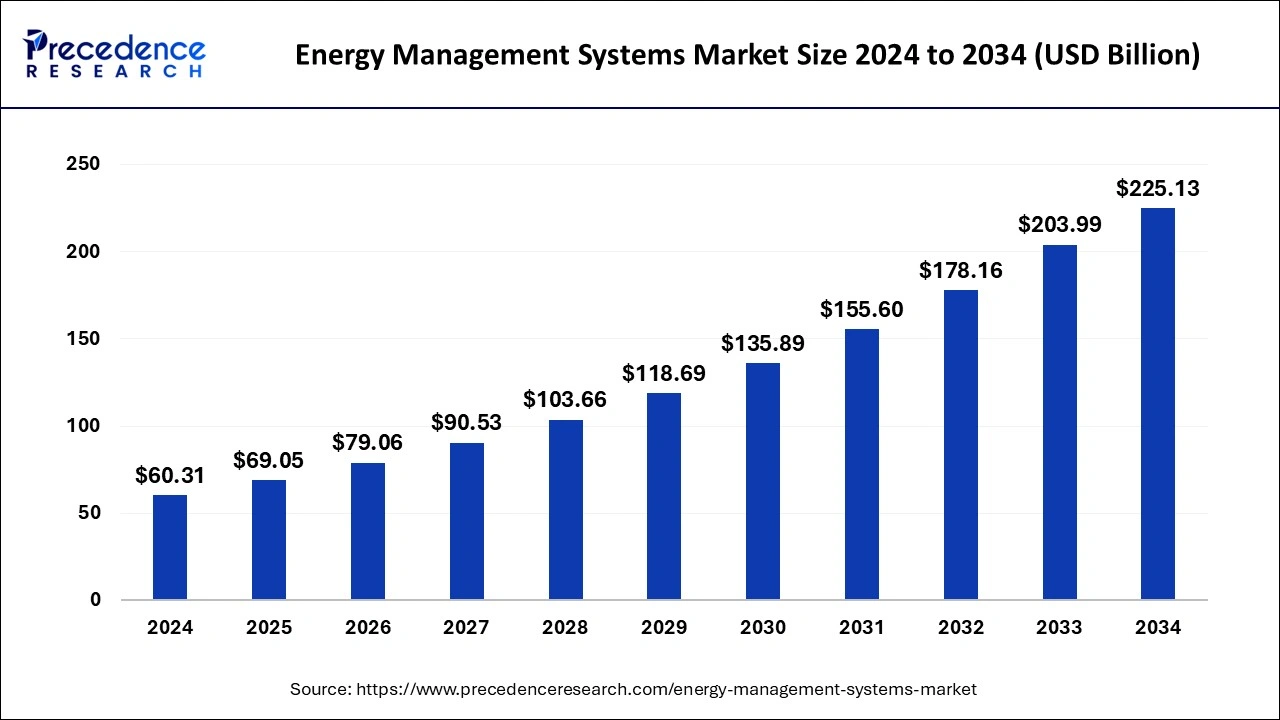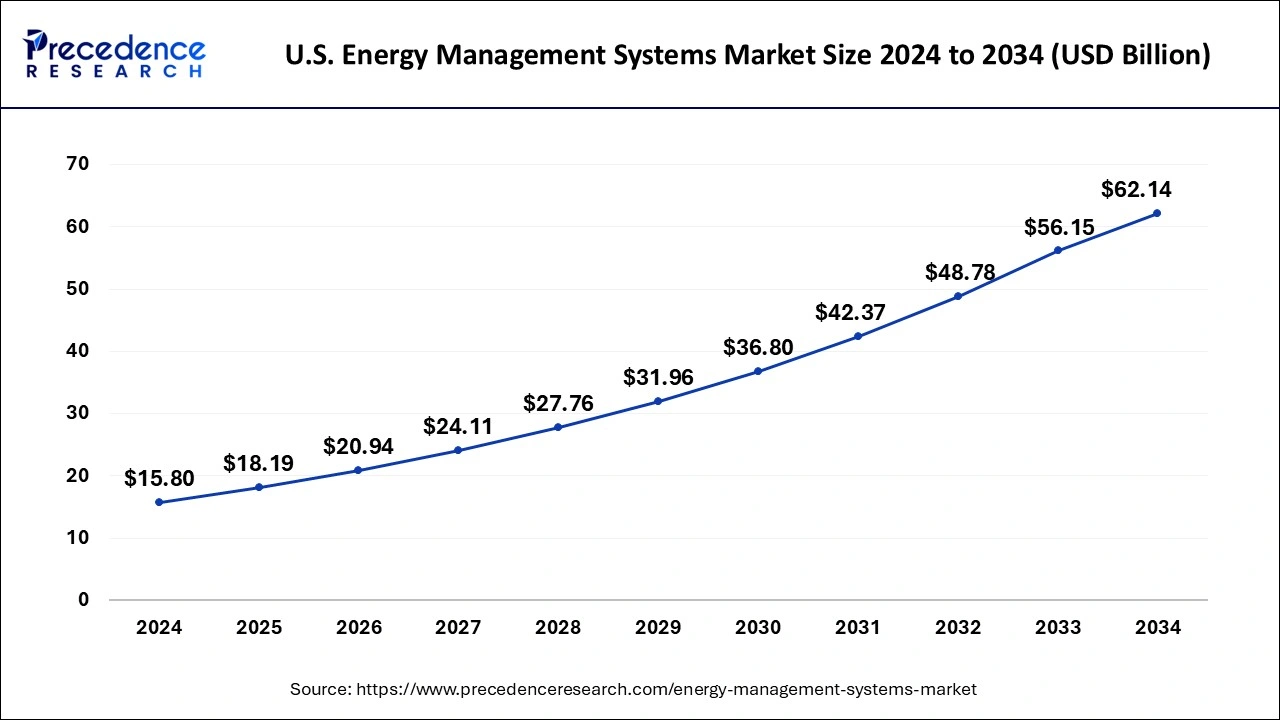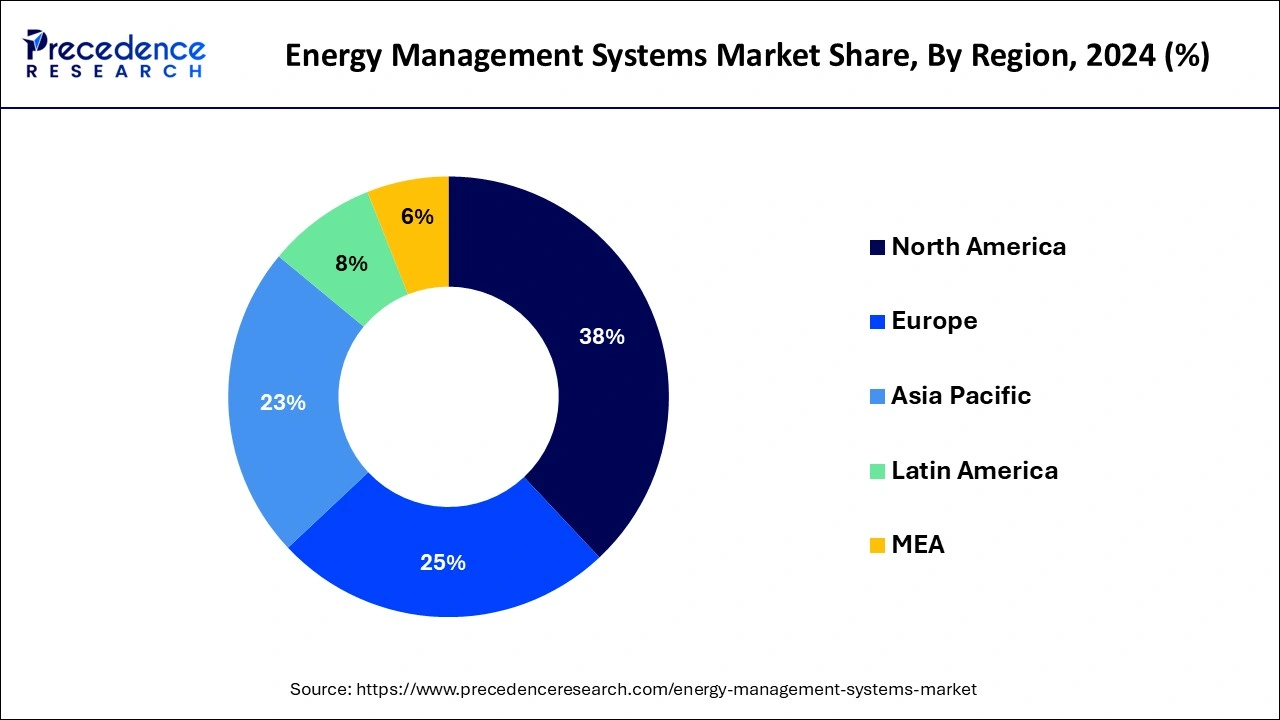January 2025
The global energy management systems market size accounted for USD 69.05 billion in 2025 and is anticipated to reach around USD 225.13 billion by 2034, accelerating at a CAGR of 14.08% from 2025 to 2034. The North America energy management systems market size surpassed USD 22.92 billion in 2024 and is expanding at a CAGR of 14.10% during the forecast period. The market sizing and forecasts are revenue-based (USD Million/Billion), with 2024 as the base year.
The global energy management systems market size surpassed USD 60.31 billion in 2024, and is expected to reach around USD 225.13 billion by 2034 with a registered CAGR of 14.08% from 2025 to 2034.

The U.S. energy management systems market size was estimated at USD 15.80 billion in 2024 and is predicted to be worth around USD 62.14 billion by 2034, at a CAGR of 14.68% from 2025 to 2034.

North America dominated the energy management systems market in 2024. The lack of electricity in some areas of Asia-Pacific is creating demand for energy management systems on a large scale. The rapid industrialization and urbanization are also driving the market growth. The high investments in the development of energy management systems are contributing towards the growth of energy management systems market in Asia-Pacific region.
North America is expected to develop at the fastest rate during the forecast period. The stringent government regulations regarding energy storage and management are driving the market growth. In addition, the government is implementing favorable policies that support the adoption of the energy systems. This factor is driving the growth of the energy management systems market in North America region.
The U.S. and Canada, as pioneers in integrating IoT technologies and smart grid infrastructures, boast a significant installed base, establishing a comprehensive ecosystem that supports the deployment of EMS across diverse sectors including commercial, industrial, and residential applications.
As awareness regarding the tangible benefits of automation and energy efficiency rises, demand for these systems is escalating, particularly in environments where high energy consumption can lead to substantial cost savings and environmental benefits.

In Europe, the energy management systems market is experiencing rapid expansion, spurred by urbanization, population growth, and a pronounced emphasis on sustainability and energy efficiency. The European Union has established ambitious objectives for reducing greenhouse gas emissions, prompting increased investment in smart grids, smart meters, and cutting-edge energy management solutions. Moreover, with a significant portion of the population migrating to urban centers—a trend exacerbated by rising temperatures and climate change—there is a burgeoning demand for HVAC systems and related energy management strategies. This evolving landscape presents a compelling opportunity for innovations that optimize energy consumption and distribution, ensuring a more sustainable future.
The energy management systems are helping in the reduction of energy costs. Even government of established and emerging nations is implementing various programs and policies in favor of adoption and acceptance of energy management systems in the global market. The energy management systems are being considered as one of the innovative technologies for the power and energy sectors.
The small and medium enterprises along with every type of industry are deploying energy management systems. Due to benefits provided by energy management systems, the demand for energy management systems is increasing at a rapid pace. One of the prominent factors driving the growth of the global energy management systems market is technological developments. In addition, the government is highly investing for the development of the energy management systems. This factor is boosting the growth of the global energy management systems market over the projected period.
The energy management systems are gaining momentum in the global market. Since few decades, the adoption of automatic energy management systems had increased at a rapid pace. The growing concerns regarding pollution and carbon emissions are supporting the expansion and development of the energy management systems market. Furthermore, the government is emphasizing the importance of energy consumption which is boosting the energy management systems market growth.
In addition, the growing use of renewable energy sources is driving the demand and need for energy management systems. The major market players are collaborating with government agencies for the development of the global energy management systems market. The energy management systems are cost effective and efficient in nature, which is creating growth prospects for the energy management systems market growth and development globally during the forecast period.
| Report Coverage | Details |
| Market Size in 2025 | USD 52.67 Billion |
| Market Size by 2034 | USD 203.99 Billion |
| Growth Rate from 2025 to 2034 | CAGR of 14.5% |
| Largest Market | North America |
| Base Year | 2024 |
| Forecast Period | 2025 to 2034 |
| Segments Covered | By Product, By Component, By Solution, By Vertical, and By End Use |
| Regions Covered |
North America, Europe, Asia-Pacific, Latin America, and Middle East & Africa |
The industrial energy management systems (IEMS) segment dominated the market in 2024. The energy management systems are highly adopted in various industries and sectors. The energy management systems are adopted in manufacturing sector on large scale.
The building energy management systems (BEMS) segment is fastest growing segment of the energy management systems market in 2024. The growing awareness about energy management systems combined with growing number of building and construction projects is contributing to the expansion of the segment over the forecast period.
The sensors segment accounted largest revenue share in 2024. The factors such as technological developments and adoption of innovative products are boosting the segment growth. There is surge in demand for sensors due to rising emphasis on tracking and monitoring data. In addition, the sensors are efficient in nature, which is boosting the growth of the energy management systems market.
The software segment is fastest growing segment of the energy management systems market in 2024. The major market players are integrating data analytics and software with energy management systems, which is driving the growth of the global energy management systems market over the projected period.
The carbon energy management segment led the market in 2024. The factors such as depletion of fossil fuels and growing concerns for environment are driving demand for carbon energy management systems. Furthermore, the carbon energy management systems are used to curb the adverse effects of carbon emissions and greenhouse gases emissions in the environment.
The utility billing and customer information system segment is fastest growing segment of the energy management systems market in 2024. The utilization of utility billing and customer information system helps in the management of customer information effectively and efficiently. This system or solution helps to reduce high costs associated with the management of customer information. It also helps to carry out day to day operations smoothly.
The power and energy segment garnered largest market share in 2024. The energy management systems are widely used in power and energy sectors. The energy management systems help to track and monitor energy utilization on a regular basis. This also helps to smooth out the operations of the industries. Thus, this factor is driving the growth of the segment.
The retail and offices segment are fastest growing segment of the energy management systems market in 2024. The adoption of energy management systems for retail and offices help to utilize energy and power without any wastage. Also, the energy consumption can be tracked through energy management systems.
The residential segment accounted largest market share in 2024. The energy management systems are being utilized for residential sector. The rising electricity billing costs in residential areas are propelling the growth of the global energy management systems market over the forecast period.
The commercial segment is fastest growing segment of the energy management systems market in 2024. The energy management systems are being utilized in various shopping malls, theatres, and business spaces. This is creating demand for energy management systems for the commercial areas and sectors.
By Product
By Component
By Solution
By Deployment
By Vertical
By End Use
By Geography
For inquiries regarding discounts, bulk purchases, or customization requests, please contact us at sales@precedenceresearch.com
No cookie-cutter, only authentic analysis – take the 1st step to become a Precedence Research client
January 2025
November 2024
October 2024
October 2024